
How to Use Analog Dissolved Oxygen: Examples, Pinouts, and Specs
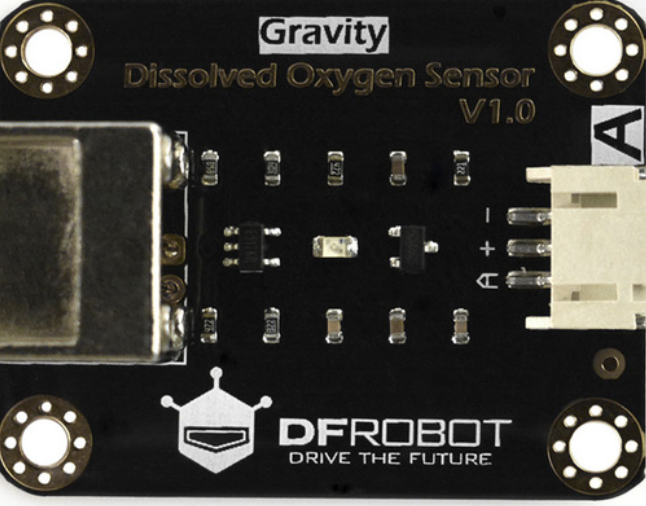
 Design with Analog Dissolved Oxygen in Cirkit Designer
Design with Analog Dissolved Oxygen in Cirkit DesignerIntroduction
The Analog Dissolved Oxygen Sensor by DFROBOT is a reliable and accurate device designed to measure the concentration of dissolved oxygen (DO) in water. It provides an analog output signal proportional to the oxygen level, making it ideal for integration into various monitoring systems. This sensor is widely used in applications such as environmental monitoring, aquaculture, hydroponics, and water quality analysis.
By converting the dissolved oxygen concentration into an analog voltage signal, this sensor enables easy interfacing with microcontrollers, such as Arduino, for real-time data acquisition and analysis.
Explore Projects Built with Analog Dissolved Oxygen
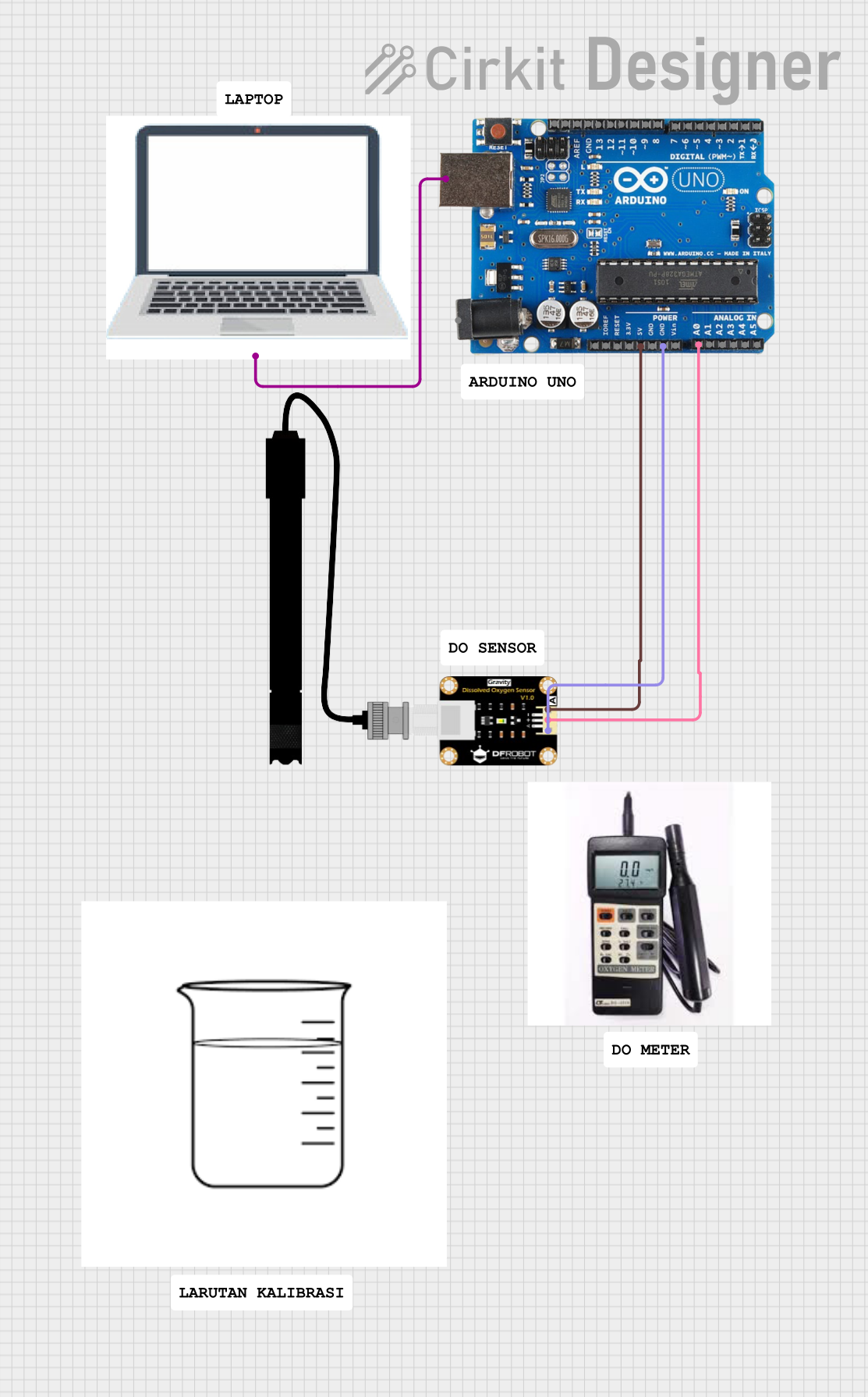
 Open Project in Cirkit Designer
Open Project in Cirkit Designer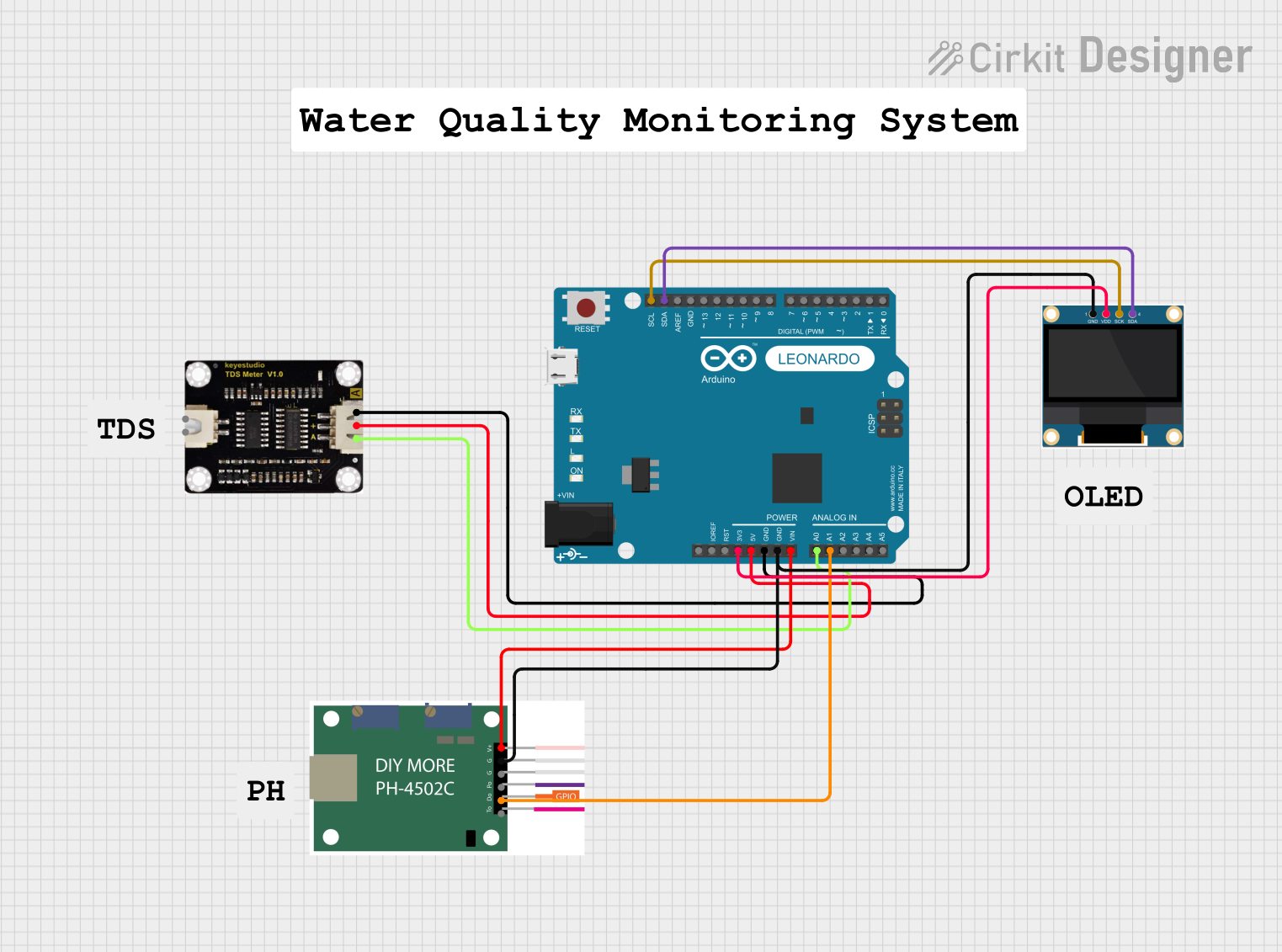
 Open Project in Cirkit Designer
Open Project in Cirkit Designer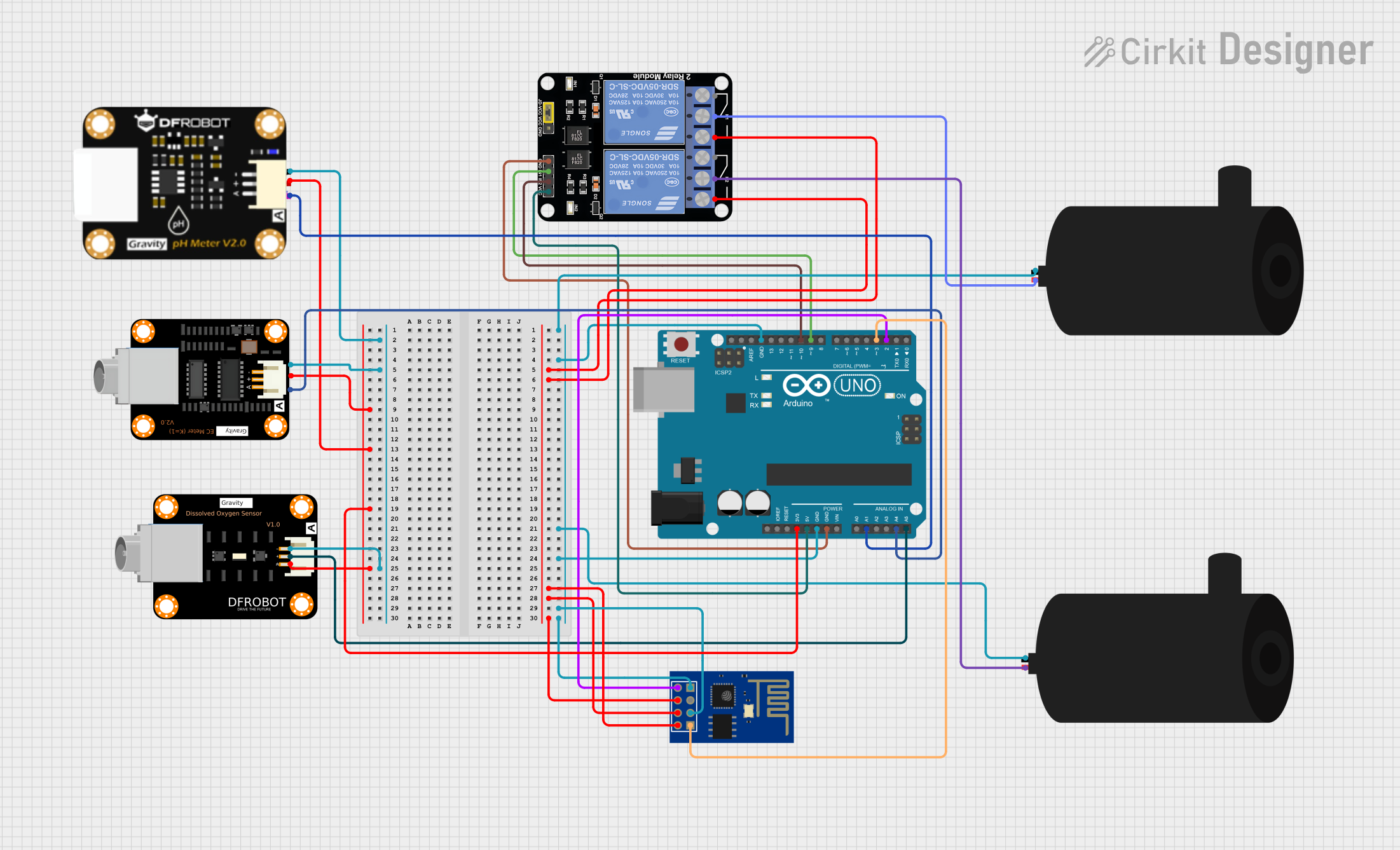
 Open Project in Cirkit Designer
Open Project in Cirkit Designer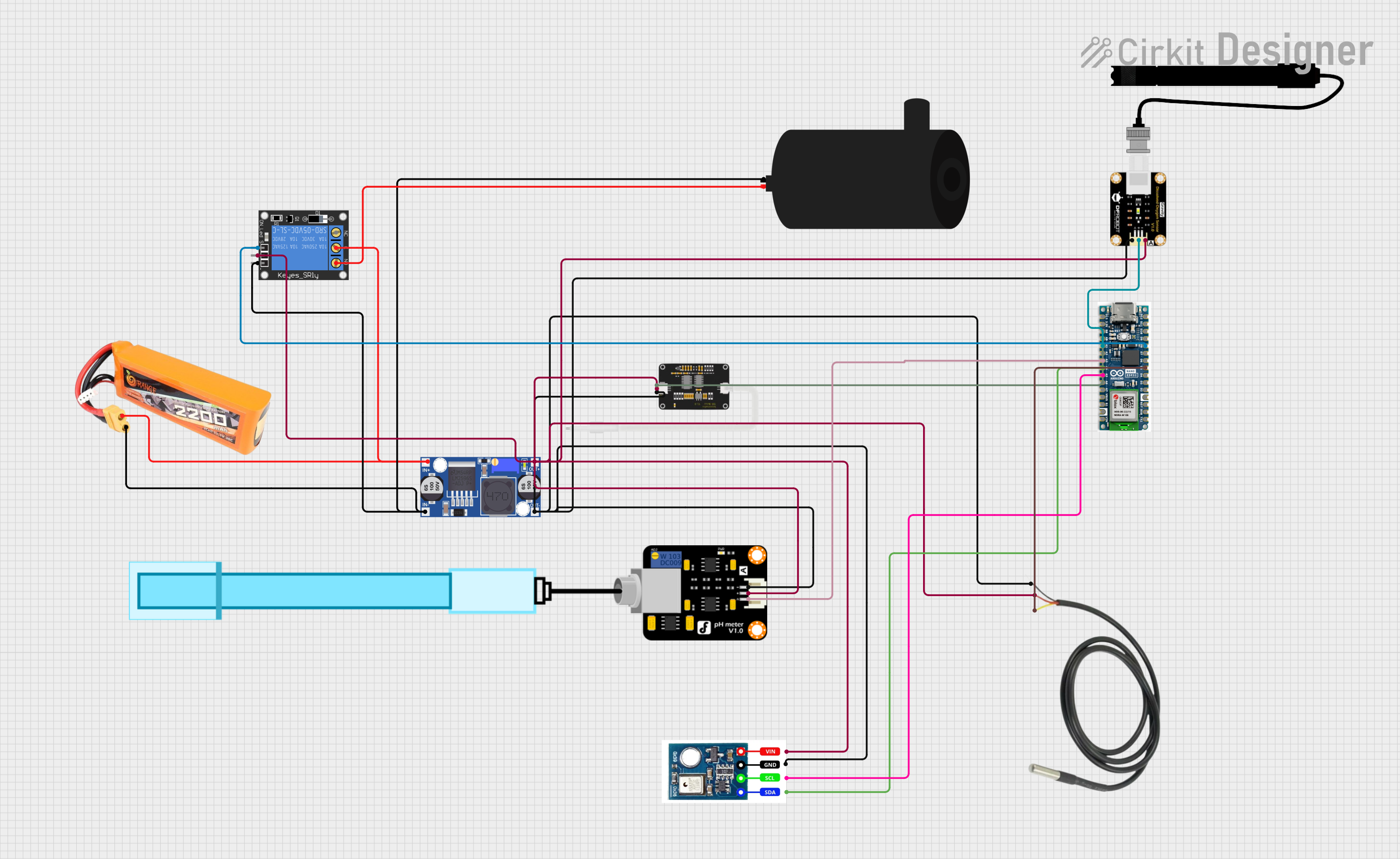
 Open Project in Cirkit Designer
Open Project in Cirkit DesignerExplore Projects Built with Analog Dissolved Oxygen

 Open Project in Cirkit Designer
Open Project in Cirkit Designer
 Open Project in Cirkit Designer
Open Project in Cirkit Designer
 Open Project in Cirkit Designer
Open Project in Cirkit Designer
 Open Project in Cirkit Designer
Open Project in Cirkit DesignerTechnical Specifications
Below are the key technical details and pin configuration for the Analog Dissolved Oxygen Sensor:
Key Technical Details
| Parameter | Specification |
|---|---|
| Operating Voltage | 5.0V DC |
| Output Signal | Analog voltage (0-3.0V) |
| Measurement Range | 0 - 20 mg/L (ppm) |
| Accuracy | ±0.1 mg/L |
| Response Time | < 60 seconds |
| Operating Temperature | 0°C to 60°C |
| Probe Material | Epoxy resin and gold-plated electrodes |
| Cable Length | 2 meters |
| Calibration Method | Single-point calibration |
Pin Configuration
The sensor module has a 3-pin interface for easy connection to a microcontroller or data acquisition system. The pinout is as follows:
| Pin Name | Description |
|---|---|
| VCC | Power supply input (5V DC) |
| GND | Ground |
| AOUT | Analog output signal (0-3.0V) |
Usage Instructions
How to Use the Sensor in a Circuit
Wiring the Sensor:
- Connect the VCC pin of the sensor to the 5V pin of your microcontroller.
- Connect the GND pin of the sensor to the ground (GND) of your microcontroller.
- Connect the AOUT pin of the sensor to an analog input pin (e.g., A0) on your microcontroller.
Calibration:
- Immerse the probe in a solution with a known dissolved oxygen concentration (e.g., air-saturated water).
- Adjust the potentiometer on the sensor module until the output voltage corresponds to the known DO value.
Reading the Output:
- The sensor outputs an analog voltage proportional to the dissolved oxygen concentration. Use an analog-to-digital converter (ADC) on your microcontroller to read the voltage and calculate the DO value.
Important Considerations and Best Practices
- Temperature Compensation: The sensor does not include built-in temperature compensation. For accurate measurements, use an external temperature sensor to account for temperature variations.
- Probe Maintenance: Clean the probe regularly to prevent fouling and ensure accurate readings.
- Avoid Air Bubbles: Ensure no air bubbles are trapped on the probe surface during measurement, as this can affect accuracy.
- Calibration Frequency: Calibrate the sensor periodically to maintain accuracy, especially in long-term applications.
Example Code for Arduino UNO
Below is an example Arduino sketch to read the analog output of the sensor and calculate the dissolved oxygen concentration:
// Analog Dissolved Oxygen Sensor Example Code
// Manufacturer: DFROBOT
// This code reads the analog output of the sensor and converts it to a DO value.
const int DO_PIN = A0; // Analog pin connected to the sensor's AOUT pin
float voltage; // Variable to store the sensor's output voltage
float doValue; // Variable to store the calculated DO value
void setup() {
Serial.begin(9600); // Initialize serial communication at 9600 baud
pinMode(DO_PIN, INPUT); // Set the DO_PIN as an input
}
void loop() {
// Read the analog voltage from the sensor
int sensorValue = analogRead(DO_PIN);
// Convert the analog reading (0-1023) to a voltage (0-5V)
voltage = sensorValue * (5.0 / 1023.0);
// Convert the voltage to a dissolved oxygen value (mg/L)
// Note: Replace the formula below with the calibration equation
// specific to your sensor setup.
doValue = (voltage / 3.0) * 20.0; // Example conversion formula
// Print the results to the Serial Monitor
Serial.print("Voltage: ");
Serial.print(voltage);
Serial.print(" V, DO: ");
Serial.print(doValue);
Serial.println(" mg/L");
delay(1000); // Wait 1 second before the next reading
}
Troubleshooting and FAQs
Common Issues and Solutions
No Output Signal:
- Ensure the sensor is properly powered (5V DC) and all connections are secure.
- Verify that the analog input pin on the microcontroller is functioning correctly.
Inaccurate Readings:
- Check if the probe is clean and free of debris or fouling.
- Perform a calibration to ensure the sensor is providing accurate measurements.
- Use temperature compensation if the water temperature varies significantly.
Fluctuating Readings:
- Ensure the probe is fully submerged in the water and no air bubbles are present.
- Minimize electrical noise by using short, shielded cables for connections.
FAQs
Q: Can this sensor be used in saltwater?
A: Yes, the sensor can be used in saltwater, but frequent cleaning and calibration are recommended to maintain accuracy.
Q: How often should I calibrate the sensor?
A: Calibration frequency depends on the application. For critical measurements, calibrate before each use. For long-term monitoring, calibrate weekly or as needed.
Q: Is the sensor waterproof?
A: The probe is waterproof and designed for submersion, but the sensor module itself should be kept dry and protected from water exposure.
Q: Can I use this sensor with a 3.3V microcontroller?
A: The sensor requires a 5V power supply. If using a 3.3V microcontroller, you may need a level shifter for the analog output signal.
By following this documentation, you can effectively integrate the DFROBOT Analog Dissolved Oxygen Sensor into your projects and achieve accurate water quality measurements.